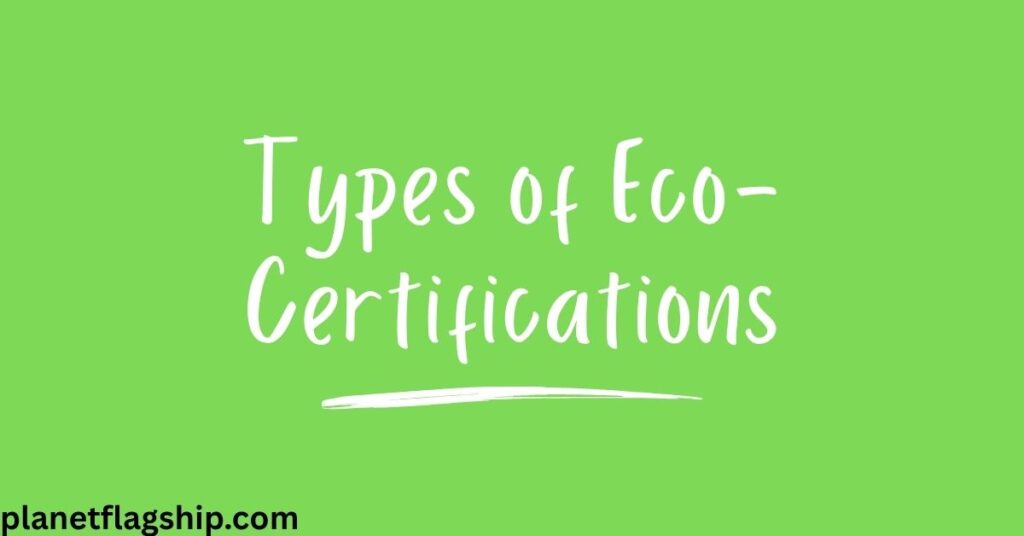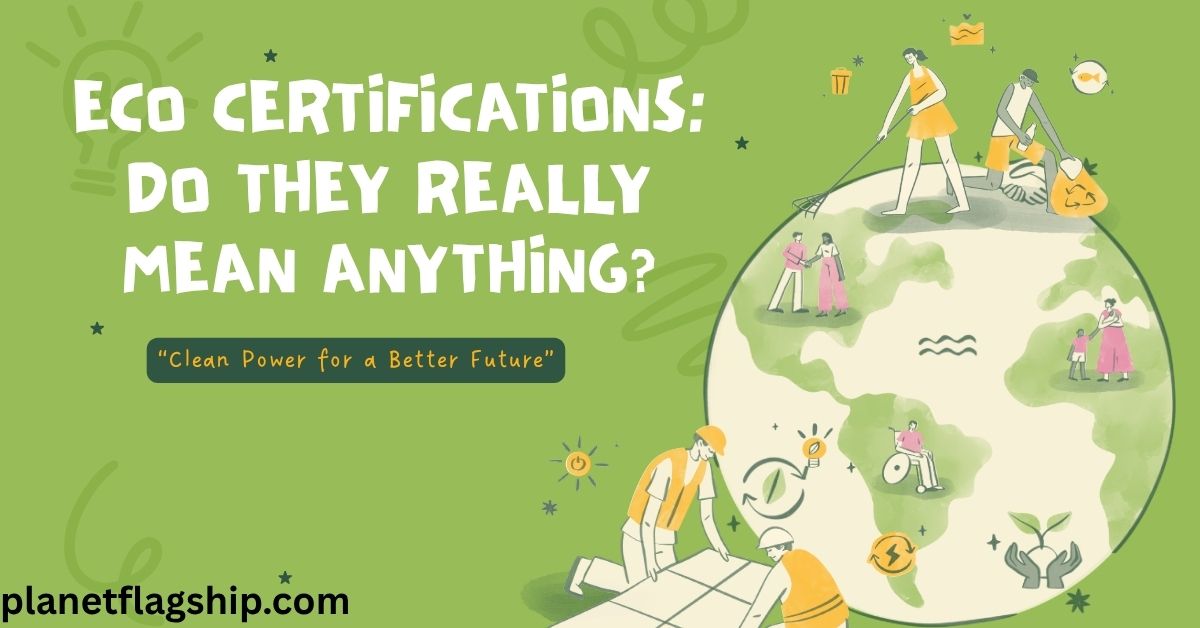Introduction
As we all know, the whole world is concerned about environmental sustainability; the terms “eco-friendly,” “sustainable,” and “green” have become more than a marketing trend, they’ve become expectations. To help purchasers make well-informed choices and to verify collective environmental claims, various eco certifications have emerged. Labels like Fair Trade, Energy Star, Forest Stewardship Council (FSC), and USDA Organic now adorn the packaging of everything from coffee to clothing.
These certifications indicate a product’s compliance with specific ethical and environmental standards. However, with the rise of these labels, a critical question arises: Do eco-certifications really mean anything?
Why is this important? Because greenwashing is an exercise where companies fabricate their environmental achievements, it can mislead consumers and undermine authentic sustainability initiatives. If ecolabels lack validity, then both the purchaser’s trust and environmental progress are at risk.
This article investigates the world of eco-certifications. It begins with an examination of what eco-certifications are and why they were established. Then, it examines the most common types of certifications and their associated legal issues. The article assesses its limitations, efficiency, and authenticity. Ultimately, we determine whether these certifications result in tangible social and ecological improvements or merely serve as window dressing.
What Are Eco-Certifications?
Eco-certifications are systematic labels attributed to organizations, products, and services that meet particular sustainability and environmentally friendly criteria.
Eco certifications extend to several fields, each focusing on environmental responsibility. Key factors include agriculture (e.g., natural farming), forestry (productive forest management), fisheries (seafood harvesting), tourism (ecotourism), and manufacturing (green production process). Additionally, energy certifications evaluate the inexhaustible energy efficiency, while construction and development depend on green architecture.
Product labeling fields verify that consumer products meet environmental standards. These certifications aim to reduce ecological footprints, encourage eco-restoration, and ensure adherence to environmental regulations, helping businesses and manufacturers develop more sustainable options.
These certifications are conscious of
- Elevate production and sustainable consumption.
- Provide clarity for consumers
- Hold companies responsible for setting standards
Eco-certifications can be managed by
- Third-party and non-profit organizations (e.g., Rainforest Alliance)
- Global organizations (e.g., ISO 14001)
- Government action (e.g., USDA Organic in the US)
ALSO READ: How Climate Change Is Creating a New Class of Refugees?
Types of Eco-Certifications

Product-Based Certifications
These emphasize the sustainability of the item itself:
USDA Organic: Verify that no synthetic pesticides were applied during food production.
ENERGY STAR: Highlight high energy efficiency in appliances.
FSC (Forest Stewardship Council) verifies that paper and wood products come from responsibly managed forests.
Practice-Based Certifications
These evaluate how the item was made:
Fair Trade: Assure safe conditions and fair wages for workers, especially in developing countries.
LEED (Leadership in Energy and Environmental Design): Emphasis on green building application and energy use.
ISO 14001: Assess environmental management systems within agencies.
Do They Really Mean Anything?
The Pros of Eco-Certifications
Eco-certifications, such as ecolabels and environmental product declarations, are tools designed to promote sustainable practices by assessing whether products or services meet specific environmental criteria. While they serve several advantages, they also pose certain challenges. The following three examples illustrate the advantages and disadvantages of ecolabels, as well as their significance.
Betterment of Product Quality and Market Scope
Thirdparty ecocertifications can move to better product quality and positive expert verification. For example, a survey of French wine found that wines with biodynamic and natural certifications received higher expert ratings compared to traditional wines, indicating that certified sustainable approaches can enhance product quality.
Promotion of Sustainable Approaches Among Producers
Eco-certifications can encourage producers to adopt environmentally friendly processes. In Thailand, organic farmers participating in eco-certification programs were more likely to adopt sustainable farming methods, resulting in a reduced environmental impact and improved product safety.
Influence on Consumer Behavior Towards Sustainability
Ecolabels serve as efficient communication tools, helping consumers make more eco-friendly and responsible purchasing decisions. By providing transparent data about a product’s environmental impact, ecolabels can shift consumer preferences toward sustainable approaches.
Real-world example
According to an article published in the Journal of Cleaner Production, verified coffee farms under the Rainforest Alliance certification had better biodiversity results and improved worker well-being compared to non-certified farms.
The Cons of Eco-Certifications

Potential for Greenwashing and Consumer Doubts
The rapid growth of unverified ecolabels can lead to greenwashing, where products are misleadingly marketed as environmentally friendly. This diminishes consumer trust and can sabotage the perceived value of verified certifications.
High Costs and Accessibility Concerns for Small Producers
The financial burden associated with obtaining eco-certifications, including inspection fees and assessment costs, can be prohibitive for small and medium-sized market trends. This may reduce their involvement in certified markets and overall involvement.
Fragmentation and Consumer doubt Due to Multiple certifications
The presence of numerous eco-certifications with changing standards can generate doubt and mistrust among producers and buyers. This fragmentation may lead to mistrust in the reliability of certifications and limit the effectiveness of ecolabeling as a means of promoting sustainability.
Case Study
In 2018, a report by the Fluctuating Markets Foundation revealed that several fashion brands claiming sustainability had ecolabels with low environmental standards, revealing a disconnect between their declarations and actual results.
Are Consumers Influenced?
A 2020 survey by the National Retail Federation reveals that nearly 75% of consumers in Canada and the United States were willing to pay for insurance from brands dedicated to sustainability. However, mistrust also runs high; more than 45% said they were unsure which labels to rely on.
Eco-friendly certifications, such as Fair Trade, USDA Organic, or Energy Star, play a crucial part in shaping consumer behavior towards buying sustainable products. In today’s environmentally conscious society, many consumers actively seek products that align with ethical and ecological practices.
These certifications provide a sense of reliability and assurance that the item meets set environmental standards. Research shows that an increasing number of people, especially Gen Z and millennials, are willing to pay a premium for environmentally friendly products.
Eco-certifications help consumers make informed, up-to-date decisions, especially when they are not well-versed in sustainability. Marketers and companies also promote these labels as part of their marketing methods, knowing that they draw attention and influence purchasing behavior.
On the other hand, some argue that eco-certifications have a restricted impact. Many consumers either do not understand the meaning of multiple certifications or do not believe them due to “greenwashing,” a practice where companies misleadingly claim to be environmentally friendly. Cost is also a major element; if eco-labeled items are significantly more costly, budget-conscious consumers may disregard the certification.
Furthermore, in areas with limited environmental awareness or restricted access to sustainable products, such labels can make a significant difference. Convenience, decision-making, brand loyalty, and price often exceed eco-certifications in purchaser priorities.
Consumer Education Is Key
- NGOs and governments can play a significant role in educating consumers and promoting the use of ecolabels on products.
- Clear justification of what a certification contains helps build trust.
- Online verification and QR code systems can elevate transparency.
The Role of Government and International Bodies

- IPCC reports emphasize the importance of structured evaluation of environmental claims to track reliable progress.
- The European Union’s Ecolabel enterprise sets a legally binding environmental guideline for products put up within the EU.
- The UN Environment Programme (UNEP) excels in ecolabeling as part of its 15-Year Framework of Initiatives on Sustainable Manufacturing.
Improving the Certification Landscape
Here are five ways to make eco-certifications more credible and impactful:
Standardize Definitions: line up certifications across industries and countries
- Enhance Audits: Use a third-party evaluation with precise verification.
- Subsidize Access: Lessen costs for small businesses to participate.
- Legislate: instruct clear disclosures and correct false claims.
- Educate: Run public awareness organizations about authentic ecolabels.
FAQ’s
What are eco-certifications and why do they matter?
Eco-certifications are labels that show a product or company follows environmental and ethical standards. They help consumers make informed, eco-friendly choices and hold businesses accountable.
Can eco-certifications be trusted?
Some certifications are trustworthy, especially those from third-party or government bodies. However, not all are equal greenwashing and weak standards can reduce credibility.
How do eco-labels influence buying decisions?
Eco-labels often guide consumers toward more sustainable choices. Many buyers, especially younger generations, prefer eco-certified products if they trust the label.
Why are small businesses less likely to get certified?
The high cost and complex process of certification make it hard for small producers to participate, even if their practices are eco-friendly. This creates a gap in fair access.
How can we improve the eco-certification system?
By setting universal standards, reducing costs for small businesses, increasing transparency, and educating consumers, we can make eco-certifications more effective and reliable.
Conclusion
Eco-certifications are a powerful tool in the fight against environmental degradation and unethical practices. Ecolabels can drive impactful change by promoting responsible production and guiding manufacturing choices. However, their success rate has not been confirmed. Weak product quality, lack of imposition, and consumer uncertainty can undermine their purpose.
The key takeaways are
- Not all eco-certifications are in the same line — transparency and authenticity matter.
- Consumers need better education to make knowledgeable choices.
- Governments and inspector organizations must enact higher standards. As individuals, we can:
- Research the definition behind the labels we observe
- Support products with eco-certifications from credible sources
- Advocate for a stringent environmental order.
By making informed choices and demanding accountability, we can transform eco-certifications into a genuine tool of change, rather than just a marketing ploy.
References
Alam, S. M. S., & Islam, K. M. Z. (2021). Examining the role of environmental corporate social responsibility in building green corporate image and green competitive advantage. International Journal of Corporate Social Responsibility, 6(1). https://doi.org/10.1186/s40991-021-00062-w
Urbanski, S. (2013). Wildland fire emissions, carbon, and climate: Emission factors. Forest Ecology and Management, 317, 51–60. https://doi.org/10.1016/j.foreco.2013.05.045
Lanfranchi, M., Giannetto, C., & Rotondo, F. (2018). Environmental strategy in business: Green Marketing communication. Journal of Corporate Responsibility and Leadership, 4(3), 111. https://doi.org/10.12775/jcrl.2017.019
Lampe, M., & Gazda, G. M. (1995). Green marketing in Europe and the United States: An evolving business and society interface. International Business Review, 4(3), 295–312. https://doi.org/10.1016/0969-5931(95)00011-n
Chan, R. Y. K., & Lau, L. B. Y. (2002). Explaining green purchasing behavior. Journal of International Consumer Marketing, 14(2–3), 9–40. https://doi.org/10.1300/j046v14n02_02
Park, J., Ko, E., & Kim, S. (2010). Consumer Behavior in Green Marketing for Luxury Brand: A Cross-Cultural Study of US, Japan and Korea. Journal of Global Academy of Marketing Science, 20(4), 319–333. https://doi.org/10.1080/12297119.2010.9707436
Chan, R. Y. K. (2001). Determinants of Chinese consumers’ green purchase behavior. Psychology
and Marketing, 18(4), 389–413. https://doi.org/10.1002/mar.1013

John is a professional blogger and passionate advocate for environmental sustainability. With years of experience exploring eco-friendly practices and green innovations, he shares insightful articles on Planet Flagship to inspire a sustainable future. John’s expertise lies in making complex environmental topics accessible and actionable, empowering readers to make meaningful changes for the planet.
